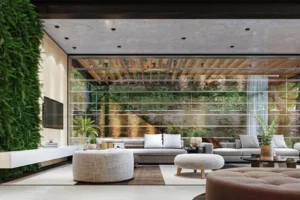Hydroponics is a method of growing plants without soil. Instead, plants grow in a nutrient-rich water solution. This system allows for precise control over nutrients, ensuring optimal growth. By eliminating soil, hydroponics can save a lot of space and water compared to traditional farming.
One of the biggest advantages is the higher yield in smaller areas. Without the need for large plots of land, you can grow more in less space. It also uses water more efficiently, which is essential in areas facing droughts. Plus, because the system is closed, there’s less need for pesticides.
In this article, we’ll focus on the future of hydroponics, especially with smart vertical farming systems. These systems are designed for small spaces, offering an innovative way to grow food at home or in urban environments. Let’s explore how technology is making these systems smarter and more accessible.
The Rise of Urban Farming and Small Space Gardening
As cities grow, the space available for traditional farming becomes more limited. With more people living in urban areas, the demand for sustainable food production methods is rising. Many are turning to smaller, space-efficient farming techniques to grow their own food.
Hydroponics plays a huge role in urban farming. It allows people to grow crops without soil, making it perfect for small apartments, rooftops, and urban environments. You can set up a hydroponic garden even if you have little space to work with. This method makes it possible to produce fresh food right at home, regardless of the location.
Small space gardening is changing how we approach food production. It encourages self-sufficiency and sustainability, offering solutions for those living in densely populated areas. With hydroponics, urban dwellers can now grow their own food without the need for large plots of land.
Vertical Hydroponics: A Game-Changer for Small Spaces
Vertical hydroponics is a farming method that uses stacked layers or towers to grow crops. Instead of spreading plants out horizontally, they grow upward, saving space and increasing efficiency. This method is a game-changer for anyone with limited room, like those living in apartments or cities.
By using vertical systems, you can grow more food in less space. These systems take full advantage of the area available, whether it’s a small corner or a rooftop. Examples include tower gardens, wall-mounted units, and modular setups that can be easily customized.
One of the key benefits of vertical hydroponics is its ability to produce more with less. Without soil, there’s no need for large plots of land. You also use fewer resources, like water and space, while getting higher yields per square foot compared to traditional gardening. It’s a smart, efficient way to grow.
The Role of Technology in Smart Vertical Systems
Technology plays a crucial role in enhancing the efficiency and effectiveness of vertical hydroponic systems. From sensors to automation, the integration of smart technology makes these systems not only easier to manage but also more productive.
Sensors are one of the key innovations in modern hydroponics. These devices can monitor things like nutrient levels, pH balance, water temperature, and humidity. By continuously tracking these factors, sensors ensure plants receive the perfect conditions for optimal growth.
Automation is another game-changer. Many systems now feature automated nutrient and water delivery, reducing the need for constant manual monitoring.
For example, instead of manually adjusting the water supply, automated systems can release the right amount of nutrients at specific times. This makes the process much easier, especially for beginners or those with limited gardening experience.
Climate control is another benefit of smart systems. Temperature and humidity can be adjusted in real-time to mimic the best conditions for plant growth. This is especially helpful in areas with unstable climates or in indoor settings, where controlling the environment can lead to more predictable results.
Similarly, lighting adjustments, like automated grow lights, help provide plants with the ideal light intensity and duration, which is essential for photosynthesis and healthy growth.
One of the most important advantages of these smart systems is the ability to collect and analyze real-time data. With this data, users can track the performance of their crops, identify potential problems before they become major issues, and fine-tune their system for the best results.
Apps or dashboards allow users to access this data remotely, providing convenience and control no matter where they are.
In addition, many advanced systems are designed to be energy-efficient. From LED lights to water-saving pumps, technology is constantly improving to make vertical hydroponics more sustainable and cost-effective.
In the future, we can expect further innovations that will make these systems even more accessible, reliable, and efficient, bringing hydroponics to a wider audience while reducing its environmental impact.
Environmental and Economic Benefits
Hydroponics offers several environmental benefits. It uses far less water than traditional farming, which is crucial in areas where water is scarce. Because the system is closed, water is recycled, reducing waste.
This method also helps lower the carbon footprint. By growing food locally, there’s less need for transportation, cutting down on emissions. Additionally, fewer chemicals are used, making it a cleaner, more sustainable option.
Energy costs are also reduced. With smart systems that control lighting and climate, energy is used efficiently, which lowers overall consumption.
From an economic perspective, hydroponics makes sense, especially in cities. It’s a cost-effective solution for growing food in small spaces. It also opens the door for urban farming businesses, providing easy access to locally grown food while offering potential for commercial-scale operations.
Challenges and Considerations
While hydroponics offers many advantages, there are a few challenges to keep in mind. The initial setup costs can be significant. Investing in quality systems, lights, and other equipment might not be cheap, especially for more advanced systems.
This upfront cost could be a barrier for some people, though the long-term savings in water and space can make it worthwhile.
Another challenge is the technical knowledge required to operate hydroponic systems. While some setups are beginner-friendly, others require a deeper understanding of the technology.
Knowing how to balance nutrients, manage pH levels, and maintain the system can be overwhelming for newcomers. Without proper care, plants may not thrive, which could lead to frustration.
Scaling up hydroponic farming for larger operations can also pose issues. While these systems work well in small spaces like apartments, it becomes more complex when trying to grow at a commercial scale.
Larger systems require more investment, higher maintenance, and constant monitoring to ensure everything runs smoothly.
Technology itself also comes with limitations. For example, smart systems, while convenient, may consume more energy than expected. These systems can also experience glitches, and parts may need replacing over time. Regular maintenance and troubleshooting are essential to keep things running efficiently.
Finally, there’s the issue of accessibility. Advanced hydroponic technology may not be available or affordable for everyone, especially in underserved areas. Bridging this digital divide will be crucial if hydroponics is to reach its full potential as a widely used solution for sustainable farming.
The Future of Smart Vertical Hydroponics
The future of smart vertical hydroponics is filled with exciting possibilities. As automation and artificial intelligence (AI) continue to advance, these systems will become more efficient and user-friendly.
For example, AI could predict the optimal time to harvest crops or adjust lighting and nutrient levels based on real-time data, ensuring plants grow in the best conditions with minimal human intervention. Automation could handle routine tasks like watering or adjusting temperature, making the process almost hands-off for users.
As technology evolves, we can expect smart vertical farming to become more common in urban settings, including homes, apartments, and even commercial farms. Cities like New York and Tokyo are already embracing hydroponics in buildings and on rooftops, showing how it can be incorporated into tight spaces.
The potential to grow food in small, unused areas within urban environments will drastically change how we think about food production.
Innovations in energy efficiency are also on the horizon. For instance, LED grow lights are becoming more energy-efficient, using less power to produce the same or better results. Water systems are also becoming more sustainable, using closed-loop systems that recycle water, which is especially important in areas with water scarcity.
This means that hydroponic farming will become a more environmentally friendly option, producing less waste and using fewer resources.
Smart vertical hydroponics could play a major role in addressing food security, especially in urban areas. With the global population increasing and traditional farming facing challenges like climate change and limited arable land, this method offers a way to grow more food locally, reducing the reliance on transportation and ensuring access to healthy, fresh food.
Looking ahead, the next decade will likely see a surge in home-based hydroponic systems. Companies like AeroGarden are already making small-scale hydroponic systems that can fit in kitchens, allowing families to grow herbs, vegetables, and even small fruits at home.
Smart city farms are also likely to grow in popularity. Cities like Singapore are already developing vertical farms within the city to meet the demand for locally grown food. Large-scale urban farming initiatives, such as the one in Chicago’s Urban Growers Collective, will continue to expand as people realize the potential for food production in urban centers.
The Bottom Line
In conclusion, smart vertical hydroponic systems offer many benefits for small spaces. They maximize space, use water efficiently, and allow for high yields in tight areas. With automation and smart technology, these systems make growing food easier and more precise.
Looking to the future, these systems will only get smarter, more efficient, and more sustainable. They could revolutionize food production in cities, making it easier to grow your own food right where you live.
If you’re looking to explore hydroponics for your own home or urban space, now is a great time to start. There are many easy-to-use systems available online, like AeroGarden or Tower Garden, which make it simple to grow herbs and veggies at home. Dive in and discover how hydroponics can be part of your modern lifestyle.




